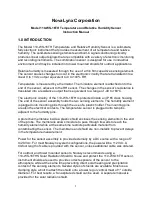
1
NovaLynx Corporation
Model 110-WS-16TH Temperature and Relative Humidity Sensor
Instruction Manual
1.0 INTRODUCTION
The Model 110-WS-16TH Temperature and Relative Humidity Sensor is a solid-state,
fully electronic instrument that provides measurement of air temperature and relative
humidity. The solid-state sensing elements and built-in signal conditioning circuitry
produces linear output signals that are compatible with a variety of electronic monitoring
and recording instruments. The combination sensor is designed for use in industrial
environment and may be installed into tower mounted shields for outdoor applications.
Relative humidity is measured through the use of a thin film capacitive sensing element.
The sensor causes changes to occur in the electronic circuitry that are translated into a
linear 0 to 1 Vdc output equivalent to 0 to 100% RH.
Temperature is measured by a thermistor. The miniature element is attached onto the
end of the sensor, adjacent to the RH sensor. The changes in the sensor’s resistance is
translated into a resistance output that is equivalent to a range of -40 to +60°C.
The electronic circuitry of the 110-WS-16TH is protected inside an IP 65 class housing.
The end of the sensor assembly holds the two sensing elements. The humidity element
is plugged onto mounting pins through the use of a plastic holder. The mounting pins
are also the electrical contacts. The temperature sensor is plugged onto two pins
adjacent to the humidity pins.
A protective membrane inside a plastic shield encloses the sensing elements in the end
of the probe. The membrane allows moisture to pass through its walls to reach the
humidity element while at the same time restricts particulate material from
contaminating the sensor. The membrane and shield are non-metallic to prevent delays
in the temperature measurement.
Power for the sensor assembly is provided externally by a DC source with a range of 7
to 28 Vdc. For most NovaLynx system configurations, the power will be +12 Vdc. A
40-foot length of cable is provided with the sensor, unless additional cable was ordered.
For outdoor and tower mounted sensors, NovaLynx recommends using a
110-WS-16THS Solar Radiation Shield to house and protect the 110-WS-16TH sensor.
Instrument shields are used to provide correct exposure of the sensor to the
atmosphere while at the same time preventing direct solar heating and precipitation
contact of the sensing elements. Several styles of shields are available. Most use a
clamping style u-bolt to attach the shield onto a tower leg or vertical mast of 1" outside
diameter. For best results, a fan aspirated shield can be used. A separate manual is
provided for the solar radiation shield.































